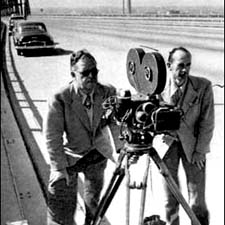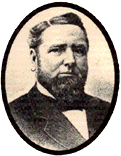|
FRESH STUFF DAILY |
|
|
||
|
|
||
|
|
||
|
SEE ALL SIGNED BOOKS by J. Dennis Robinson click here |
||
So many movie scripts, so little time. Oscar winner Louis de Rochemont had big plans to make more Seacoast movies. There was one about a Portsmouth tycoon, another about an island murder and a third about a lively boy from Exeter. But alas, even the prolific de Rochemont could not do it all. A rare behind-the-scenes report.
SEE: De Rochemont FILMOGRAPHY Few filmmakers had more impact on America in the first half of the 20th century than Newington, NH's Louis de Rochemont. His company's 300 short March of Time news capsules were seen by millions of theater-goers each month, shaping their views of the world. By the end of WWII, de Rochemont was hungry to make feature-length movies about real stories, especially those he had heard and loved during his childhood. De Rochemont worked hard to build a reputation, traveling the world to shoot documentary news footage. After two Academy Awards he was able to convince a major Hollywood studio to sign a three-picture deal. The catch was that de Rochemont could shoot his pictures anywhere he chose. He chose Seacoast, NH. The trio of local films included Lost Boundaries, Whistle at Eaton Falls and Walk East on Beacon Street. Each was shot within an hour's drive of de Rochmemont's Newington, NH home at "Blueberry Hill." Each was based around actual news stories. Always an "idea man," de Rochemont collected compelling human stories, especially those from Seacoast NH. In 1948, he told a Portsmouth Herald reporter about three local stories he planned to film. Just before his death three decades later, he still held out hope of making them. Plupy Shute of Exeter
Already an amateur newsreel producer in his early teens, young de Rochemont tried to convince Plupy creator Henry Augustus Shute to sell him the film rights. The author, also a police judge in Exeter, did not grant the rights to de Rochemont, who never lost interest in the project. It was a full half century later that the filmmaker, then in his 70s, finally got the movie rights to Plupy Shute from the author's surviving relatives. Interviewed in 1974, four years before his death, de Rochemont was still raring to go on the film. The fictional Plupy grew up in post-Civil War Exeter, NH. De Rochemont had no hang-ups about shifting the time period and was planning a more modern setting. The filmmaker told a reporter that he planned to use local houses and local child actors to keep the budget in the $250,000 range. The producer said he could easily raise the necessary funds. But despite 60 years of planning, the project never got off the ground. Tycoon Frank Jones
He was as far as to publicly announce the Frank Jones film project in February 1948 when he was at the peak of his career. His three-picture agreement with Metro-Goldwyn-Mayer gave him unprecedented freedom to shoot whatever and wherever he chose. De Rochemont was attracted to the "rags-to-riches" story of Jones, who grew from a penniless immigrant [Ed: actually a far boy from Barrington.] to a powerful deal-maker. Besides a rich and successful brewer, Jones became a railroad magnate, an advisor to presidents, a real estate tycoon, an insurance executive and a banker. He also invested more than half a million dollars in the up and coming new telephone company at the turn of the 20th century. Unfortunately he picked the Drawbaugh Telephone Syndicate that lost the patent war to the Bell Telephone Company. Even Frank could not win them all. Louis never made this film either. The Frank Jones story was finally told in a detailed 1976 biography by journalist Ray Brighton. So far no one has picked up the movie option on "Citizen Jones".
Murder on Smuttynose Island How would maverick filmmaker de Rochemont react, one wonders, to news that female filmmaker Kathryn Bigelow has now made a movie that he planned to do? Bigelow’s film is adapted from the novel by Anita Shreve that is based, in part, on the 1873 Smuttynose murders at the Isles of Shoals just off the NH and Maine coastline.
The Smuttynose project contained all the elements of a blockbuster film -- sexuality, scandal, money, celebrity, poverty, scenery, mystery and murder. The story was an example, according to de Rochemont, that the local Seacoast area had an "almost inexhaustible wealth" of motion picture material. Unlike modern director Bigelow who shot the film in Canada, de Rochemont wanted to film the story near where it occurred. He continued to believe that real life stories shot with lesser known actors in authentic settings would attract large audiences. De Rochemont was addicted to "true life" dramas, cut from the daily news as in his Academy Award winning March of Time newsreel series in the 1930s. He was attracted to the story, he said, not as much for the gruesome murder, as for its aftermath. The trial of Louis Wagner became a 19th century media circus. According to DeRochemont the was primarily a movie about journalism gone amuck, of reporters more interested in the myths of the murder than in the facts. It would be interesting, even now, to compare de Rochemont's "lost" script treatment to the commercially and critically unsuccessful weight of Water. In his booklet "Murder at Moonlight," Isles of Shoals historian Lyman Ruttledge mentions de Rochemont's lost Smuttynose screenplay. But according to de Rochemont's grandson, Shaler McKeel, the manuscript has not actually been lost for the past 30 years. McReel says he has seen a copy, and in de Rochemont's 1952 version, the story was heavily modernized. Instead of Louis Wagner rowing 10 miles to the Isles of Shoals, de Rochemonts's main character hitch-hikes up the local highway to a hotel in New Castle. He is picked up by a woman driving a sports car. In de Rochemont's retelling of Seacoast history, according to his grandson, facts were flexible, but the truth was not. Copyright © 1997. Updated 2005 SeacoastN.com / J. Dennis Robinson. All rights reserved.. Please visit these SeacoastNH.com ad partners.
News about Portsmouth from Fosters.com |
| Wednesday, April 24, 2024 |


|
Copyright ® 1996-2020 SeacoastNH.com. All rights reserved. Privacy Statement
Site maintained by ad-cetera graphics







 Long forgotten except by die-hard local readers, Exeter's Plupy a Real Boy was once compared to Mark Twain's Huck Finn and Tom Sawyer. Born in 1899, like most local boys of his era, Louis de Rochemont fell in love with the misadventures of Plupy Shute and his mischievous friends. For the young de Rochemont in 1914, Plupy held the appeal young boys of future generations would find in The Young Rascals, the Hardy Boys, the Justice League of America or the Mighty Morphin Power Rangers.
Long forgotten except by die-hard local readers, Exeter's Plupy a Real Boy was once compared to Mark Twain's Huck Finn and Tom Sawyer. Born in 1899, like most local boys of his era, Louis de Rochemont fell in love with the misadventures of Plupy Shute and his mischievous friends. For the young de Rochemont in 1914, Plupy held the appeal young boys of future generations would find in The Young Rascals, the Hardy Boys, the Justice League of America or the Mighty Morphin Power Rangers.

















